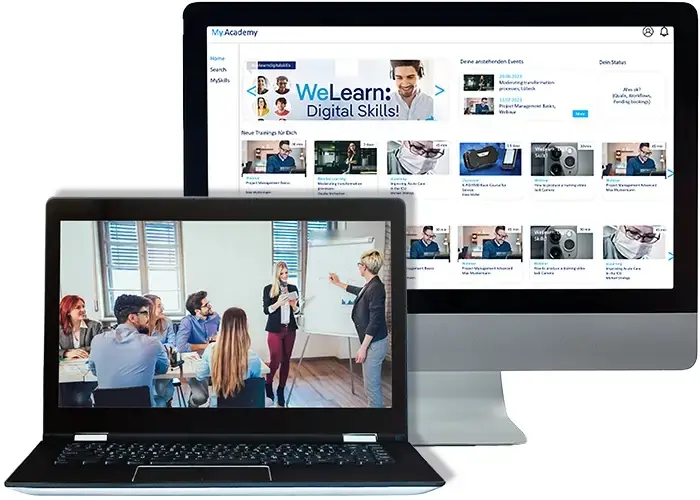How the Degree of Your Training Complexity indicates Need for an LMS

|
Implementing a Learning Management System (LMS) isn’t just a matter of the number of trainings or the size of the organization—it’s also about the complexity level of the training programs being conducted. As the complexity of training content and requirements increases, it becomes harder to manage efficiently without a digital system. An LMS helps manage this growing complexity, improving training efficiency while reducing costs. Discover how to assess the complexity of your training programs to make informed decisions about investing in an LMS. |
1. What is Training Complexity?
Complexity refers to the intricacy of the content and the effort required to organize and conduct training. Several factors contribute to this complexity, such as the number of trainings, the type of learning goals, the target audience, and the training formats used.
A helpful way to evaluate the complexity of training is to use learning goal taxonomies, which divide trainings into three categories:

- Cognitive Goals: Trainings focused on knowledge transfer, problem-solving, and thinking processes, such as technical or professional training that delivers new knowledge or enhances intellectual skills.
- Psychomotor Goals: These trainings focus on manual or motor skills, such as technical training or safety courses that require hands-on practice.
- Affective Goals: Trainings aimed at changing attitudes, behaviors, and values, such as leadership development or corporate ethics training.
2. Additional Factors That Increase Complexity
Beyond learning goal taxonomies, other factors contribute to training complexity and help decide when an LMS becomes necessary:

| Depth and Variety of Content: | The more comprehensive and interdisciplinary the training content, the higher the planning effort required. |
| Technological Dependencies: | Trainings requiring special software, simulation tools, or other technical infrastructures increase complexity. An LMS helps manage and integrate these tools effectively. |
| Heterogeneity of the Audience: | A diverse range of participants with different backgrounds and experiences requires more customization. An LMS enables personalized learning paths and tailored content. |
| International and Multilingual Training: | Trainings for global teams bring linguistic and cultural challenges that are easier to overcome with an LMS. |
| Frequency and Duration of Training: | Regular training with changing participants or long learning cycles require structured organization, which can be supported by an LMS. |
| Interactive Learning Methods: | Complex trainings often rely on interactive formats, such as simulations, group work, or role-playing. An LMS simplifies the coordination of these methods. |
| Regulatory and Compliance Requirements: | Trainings that must meet legal or industry-specific standards require extensive documentation. An LMS ensures complete traceability and certification. |
| Personalization and Customization: | The more tailored the content is to the individual needs of learners, the more complex the training becomes. An LMS supports adaptive learning paths, making it easier to personalize content. |
3. Formula for Calculating the Degree of Training Complexity
Combining learning goals with the additional factors outlined provides a comprehensive framework for calculating a training’s complexity level. A simple formula for determining the degree of complexity could look like this:


Why This Formula is Useful:
The flexibility of the weightings allows companies to adjust the importance of each factor to match their specific needs. A higher complexity level signals a growing need for an LMS to manage training efficiently, reduce costs, and ensure quality control.
Formula Explanation:
- F₁, F₂, ..., Fₙ: The ratings of the individual factors (e.g., content depth, heterogeneity, etc.), assessed on a scale of 1 to 10 for each training session.
- W₁, W₂, ..., Wₙ: The weightings for each factor, indicating how important each factor is relative to the others (e.g., weighting between 0 and 1, or 0% to 100%).
- The denominator (the sum of the weightings) ensures that the resulting complexity score is a standardized average value.
Factors with Weighting:
- Content Depth (F₁): How complex and detailed is the content of the training?
- Weighting: W₁
- Weighting: W₁
- Audience Diversity (F₂): How varied is the audience in terms of prior knowledge, role, or language?
- Weighting: W₂
- Weighting: W₂
- Interactivity (F₃): How interactive is the training? The more hands-on or interactive elements, the more complex the training becomes.
- Weighting: W₃
- Weighting: W₃
- Cognitive Goals (F₄): How much focus is on cognitive learning and problem-solving?
- Weighting: W₄
- Weighting: W₄
- Psychomotor Goals (F₅): Does the training involve manual or motor skills?
- Weighting: W₅
- Weighting: W₅
- Affective Goals (F₆): To what extent does the training focus on emotional learning objectives or behavior change?
- Weighting: W₆
- Weighting: W₆
- Duration of Trainings (F₇): How long are the training sessions on average?
- Weighting: W₇
- Weighting: W₇
- Number of Trainings (F₈): How many different training sessions need to be organized?
- Weighting: W₈
- Weighting: W₈
- Number of Target Groups (F₉): How many different target groups need to be trained?
- Weighting: W₉
- Weighting: W₉
- Geographical Distribution (F₁₀): Are the trainings held locally, nationally, or internationally? Trainings across different locations or countries increase the complexity.
- Weighting: W₁₀

Example Calculation:
Suppose a company evaluates the factors and assigns the following ratings and weightings:
- Content Depth (F₁ = 8, W₁ = 0.2)
- Audience Diversity (F₂ = 7, W₂ = 0.15)
- Interactivity (F₃ = 6, W₃ = 0.1)
- Cognitive Goals (F₄ = 9, W₄ = 0.2)
- Psychomotor Goals (F₅ = 5, W₅ = 0.05)
- Affective Goals (F₆ = 7, W₆ = 0.1)
- Duration (F₇ = 8, W₇ = 0.05)
- Number of Trainings (F₈ = 6, W₈ = 0.05)
- Number of Target Groups (F₉ = 7, W₉ = 0.05)
- Geographical Distribution (F₁₀ = 4, W₁₀ = 0.05)

This results in a complexity level of 7.25, indicating a relatively high complexity of the training portfolio.
4. Complexity Level in Relation to Resources and Efficiency Potentials
The higher the calculated complexity factor, the greater the organizational effort required, and the more obvious the need for a structured digital solution becomes.
The complexity level of a training portfolio provides important insights into the demands on a company. However, this metric is most meaningful when considered in relation to existing resources and the current efficiency of training processes. To decide whether and when an LMS is needed, the following resources and performance indicators should be taken into account:

1. Training Department Staff
A high complexity level often requires extensive planning, management, and execution of trainings. The question is how many staff members are available to manage the training administration.
- Indicator: If the complexity level is high but the number of training administrators is relatively small, this often leads to bottlenecks and inefficient use of resources. In such cases, an LMS is needed to reduce administrative effort and optimize staff deployment.
- Example: In a company with a high number of training programs, target groups, and geographically dispersed locations, which are managed by a small team, an LMS can significantly increase efficiency.
2. Error Rate and Quality Gaps in Training Management
The more complex the training system, the more likely errors occur — whether in assigning trainings, scheduling, or documenting participant results.
- Indicator: High error rates in training administration, such as incorrectly assigned participants, missed deadlines, or insufficiently documented training results, indicate the need to automate and standardize these processes through an LMS.
- Example: If 10% of training participants receive the wrong training or results are not correctly documented, an LMS can reduce this error rate to nearly 0%, offering automations and workflows.
3. Efficiency Improvement Potential
LMSs can often lead to significant time and cost savings. If the complexity level of the training portfolio is high, current resources should be evaluated for their efficiency:
- Indicator: How much time is currently spent on organizing, documenting, and tracking trainings? How many manual processes could be automated by an LMS? Comparing current resource usage with the potential savings from an LMS (e.g., faster course assignments or automatic reminders for training deadlines) reveals whether an LMS is justified.
- Example: If training administrators spend an average of one hour per participant on planning and documentation, and this time could be reduced by 70% with an LMS, the impact of an LMS on efficiency becomes clear.
4. Scalability of Training Processes
Another factor that relates the complexity level to available resources is a company’s ability to scale its training processes.
- Indicator: If the complexity of the training offering grows, but the company is unable to scale efficiently with its existing resources, implementing an LMS becomes critical.
- Example: Companies looking to rapidly expand their workforce or training volume must be able to flexibly adapt their training processes. Without an LMS, there is a risk of losing efficiency and quality.
5. Current Training Duration and Turnaround Times
A high complexity level often leads to longer training times or delays in the completion of training processes. It is important to evaluate how much time and resources are currently spent on the execution and organization of trainings.
- Indicator: How long does it currently take to create new trainings and assign them to employees? Are there delays in evaluating training results or certifications? A high complexity level combined with long turnaround times strongly suggests that an LMS is needed to accelerate these processes.
- Example: If the assignment of mandatory trainings takes an average of 5 days due to the complexity of the program, an LMS could reduce this process to just a few hours.

6. Cost Pressure and Budget Constraints
A high complexity level often results in rising costs for training management. The question is whether the current budget for manually managing and executing trainings is being used efficiently.
- Indicator: High training and administrative costs, which arise from the complexity of the training portfolio, can be reduced by using an LMS. This is particularly relevant for companies with limited training budgets.
- Example: A company with high travel costs for in-person trainings could achieve significant savings by implementing an LMS that supports virtual or blended learning formats.
5. Benefits of an LMS for Complex Trainings
An LMS offers several advantages for managing complex trainings:

- Automation of Processes: Routine tasks such as managing registrations, certification, and reporting can be automated through an LMS, saving valuable time.
- Cost Efficiency: Switching to e-learning and blended learning formats can reduce travel costs, room rentals, and instructor fees.
- Scalability: An LMS makes it easy to scale training quickly and efficiently to large audiences without compromising quality.
- Sustainability: Trainings can be standardized and delivered consistently across the organization, regardless of location or language.
6. Complexity as a Key to LMS Decision-Making
The complexity level of a training provides a clear decision-making tool for LMS implementation. The more complex the content, participant profiles, and learning methods, the more essential an LMS becomes for efficiently organizing training and ensuring learning quality. An LMS helps companies not only optimize their training processes but also reduce costs and improve efficiency in the long run.
Companies offering trainings with a high complexity level should seriously consider the introduction of an LMS as a strategic move toward modernizing and digitizing their learning processes.
Conclusion:
While the complexity level alone provides important information on whether an LMS is appropriate, the full picture emerges when it is analyzed in conjunction with current resources and processes.
An LMS becomes essential when:
- the complexity level is high,
- error rates are increasing,
- resources for training management are limited, or
- the potential for improvement through automation and digitization is significant.
Ready for the Future?
The educational landscape is changing rapidly—be prepared to implement innovative solutions and seize the opportunities that arise. Utilize the possibilities offered by modern seminar management software and LMS to optimize your offerings and meet the needs of your participants.

About Us
Since 1998 SoftDeCC is working closely with major training centers and academies. This results in a unique experience with training requirements.
Our Learning Management System TCmanager® is designed to adjust to individual corporate learning processes and address evolving challenges. More...

Free Consultancy
Discuss your Training Challenge with us.
Call +49 (0)89 / 309083930 to arrange for your free consultancy.
%20(1).webp)




